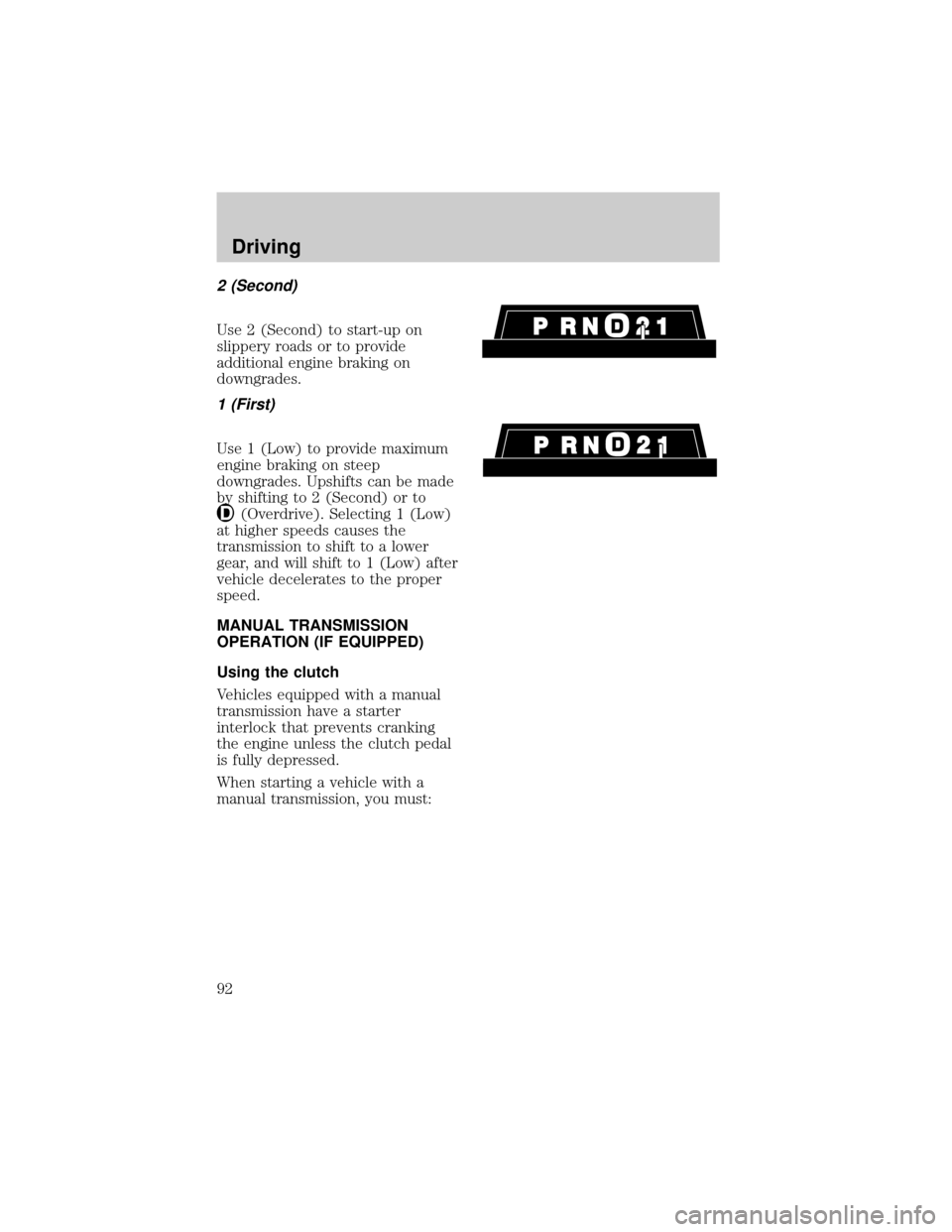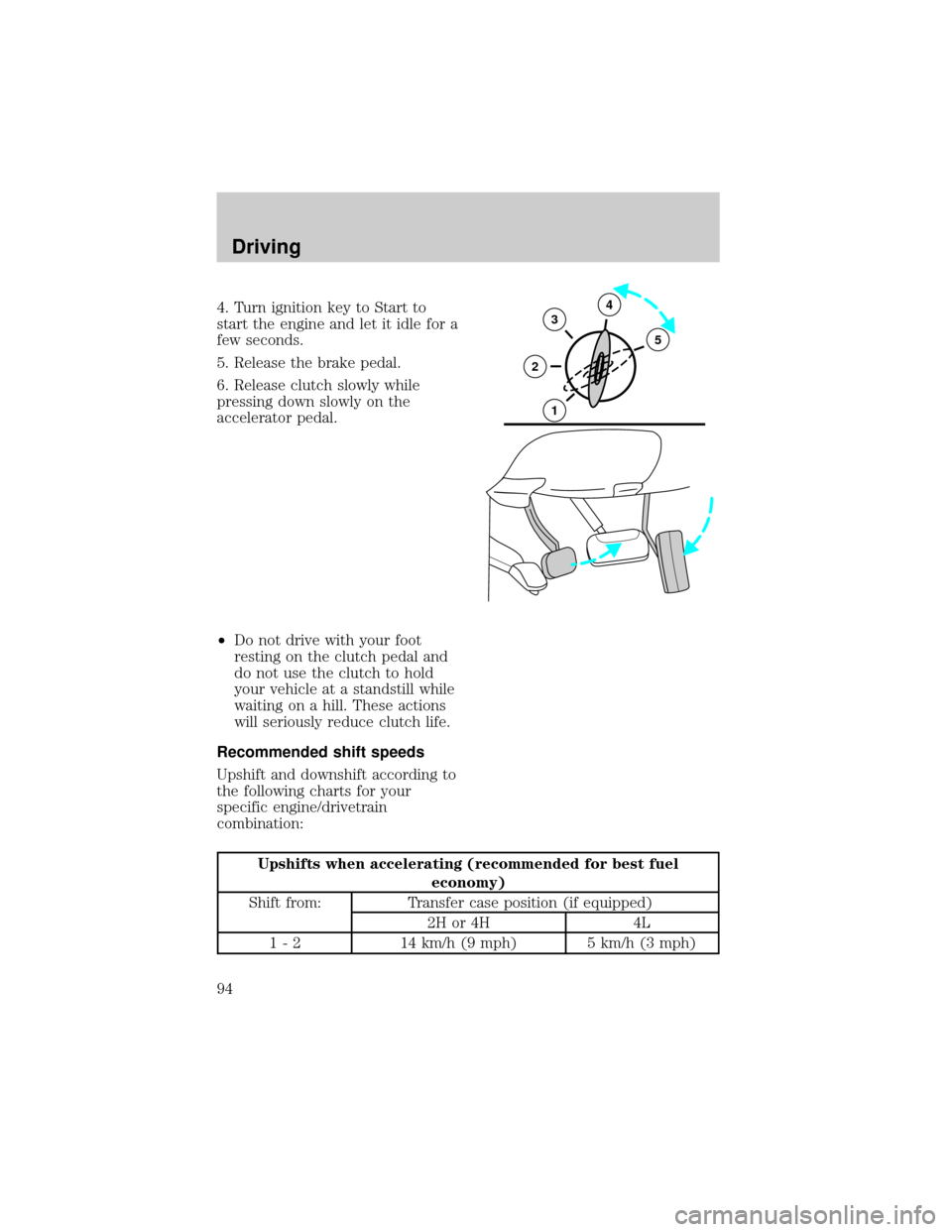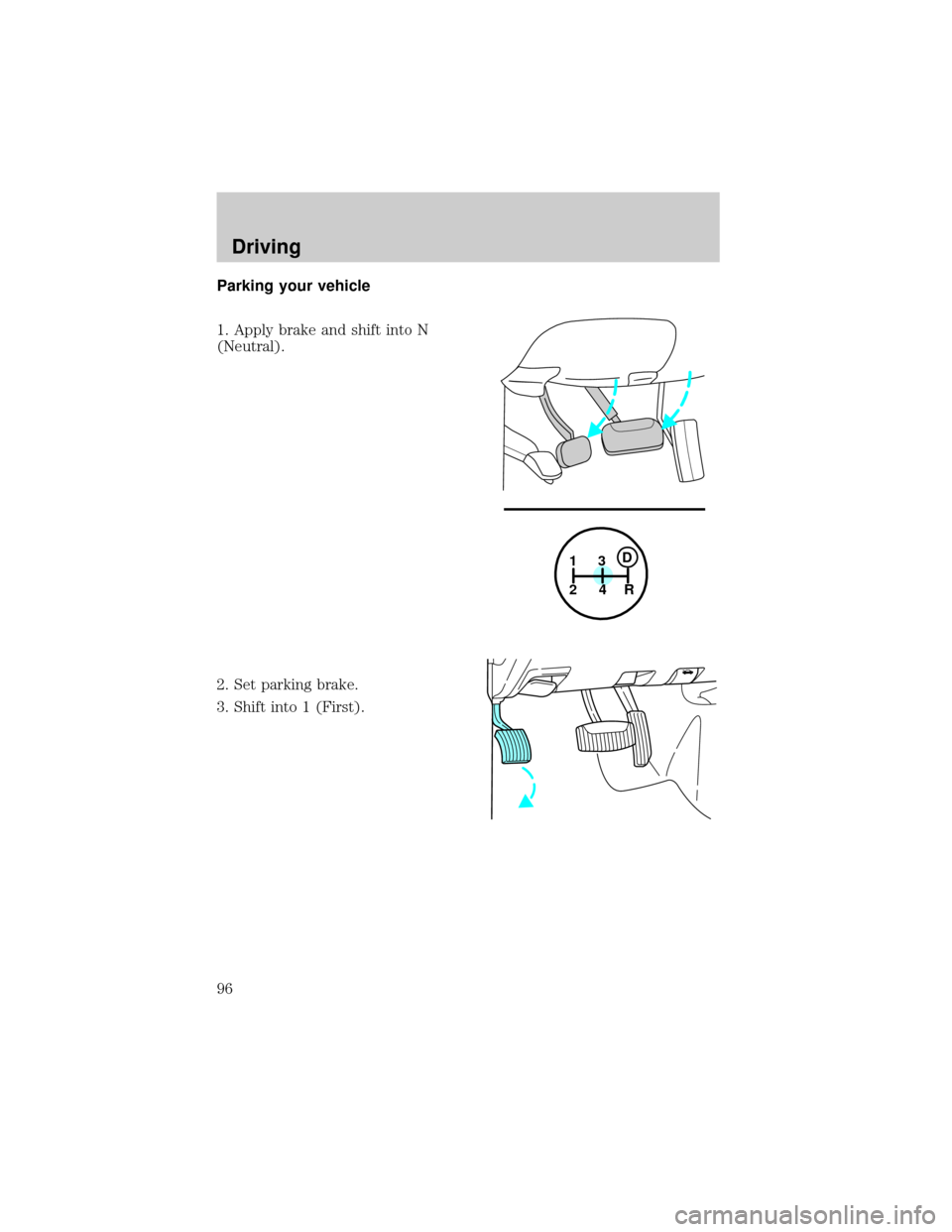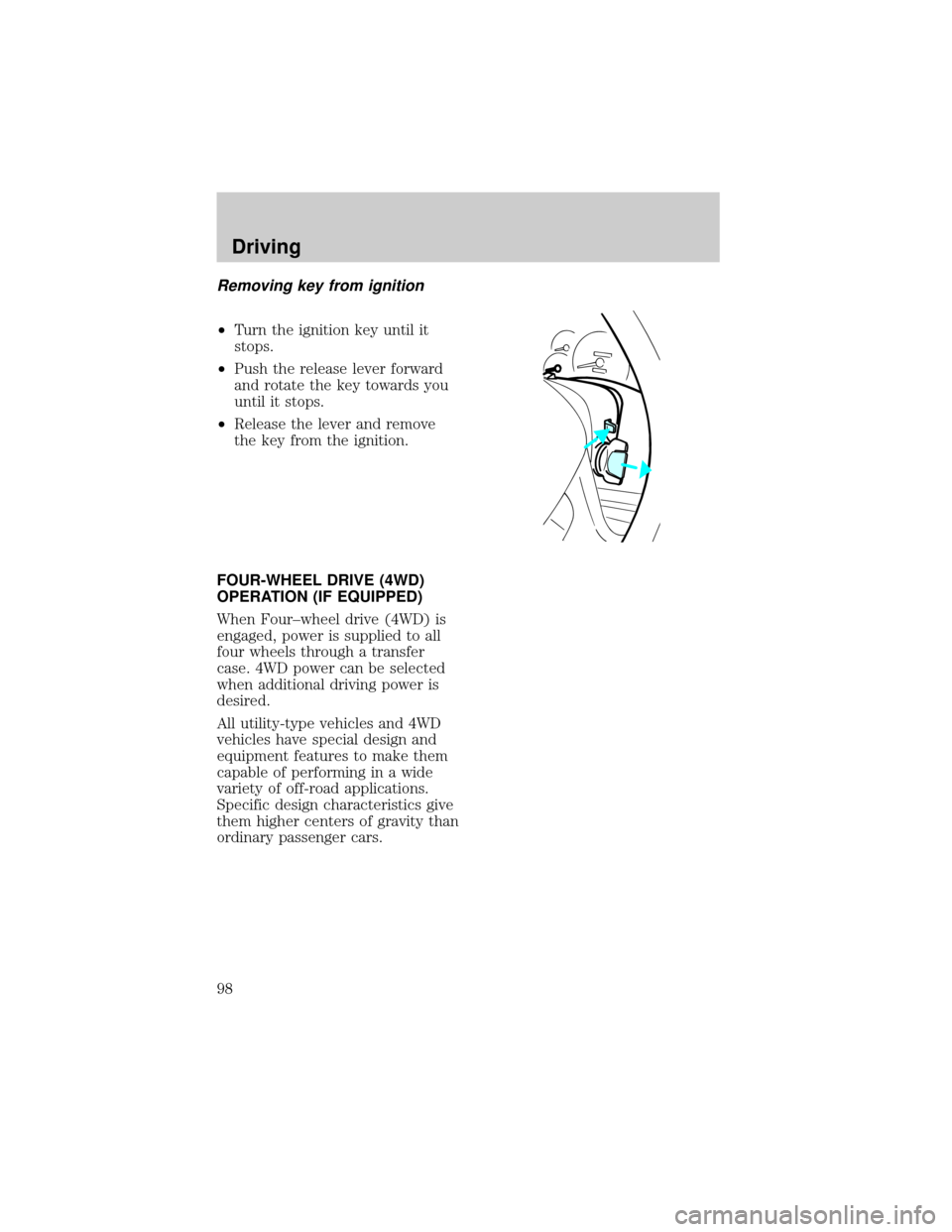FORD F150 1998 10.G Owners Manual
F150 1998 10.G
FORD
FORD
https://www.carmanualsonline.info/img/11/5017/w960_5017-0.png
FORD F150 1998 10.G Owners Manual
Trending: wiper blades, wiper fluid, winter tires, check engine light, battery capacity, jump start, seats
Page 91 of 219
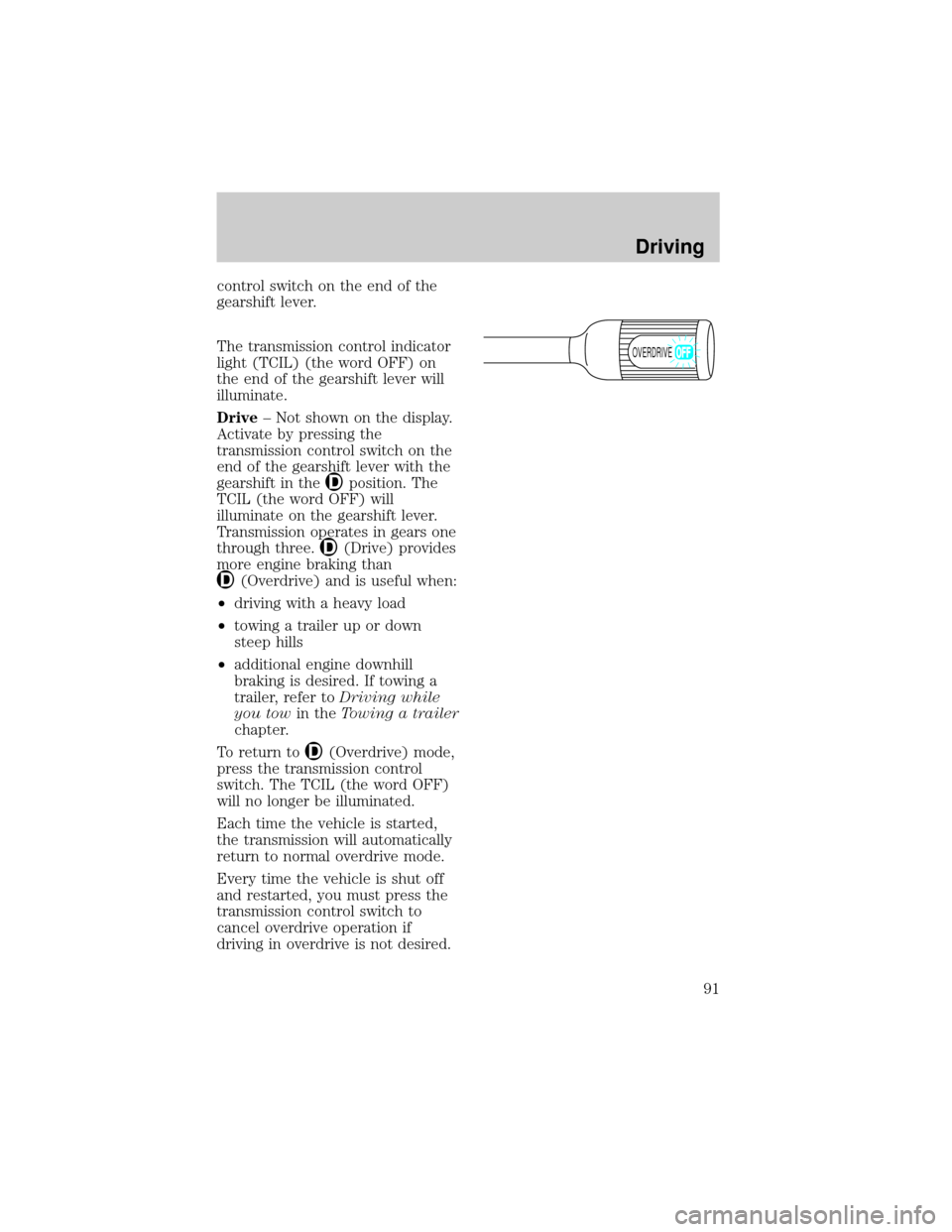
control switch on the end of the
gearshift lever.
The transmission control indicator
light (TCIL) (the word OFF) on
the end of the gearshift lever will
illuminate.
Drive± Not shown on the display.
Activate by pressing the
transmission control switch on the
end of the gearshift lever with the
gearshift in the
position. The
TCIL (the word OFF) will
illuminate on the gearshift lever.
Transmission operates in gears one
through three.
(Drive) provides
more engine braking than
(Overdrive) and is useful when:
²driving with a heavy load
²towing a trailer up or down
steep hills
²additional engine downhill
braking is desired. If towing a
trailer, refer toDriving while
you towin theTowing a trailer
chapter.
To return to
(Overdrive) mode,
press the transmission control
switch. The TCIL (the word OFF)
will no longer be illuminated.
Each time the vehicle is started,
the transmission will automatically
return to normal overdrive mode.
Every time the vehicle is shut off
and restarted, you must press the
transmission control switch to
cancel overdrive operation if
driving in overdrive is not desired.
OVERDRIVE
Driving
91
Page 92 of 219
2 (Second)
Use 2 (Second) to start-up on
slippery roads or to provide
additional engine braking on
downgrades.
1 (First)
Use 1 (Low) to provide maximum
engine braking on steep
downgrades. Upshifts can be made
by shifting to 2 (Second) or to
(Overdrive). Selecting 1 (Low)
at higher speeds causes the
transmission to shift to a lower
gear, and will shift to 1 (Low) after
vehicle decelerates to the proper
speed.
MANUAL TRANSMISSION
OPERATION (IF EQUIPPED)
Using the clutch
Vehicles equipped with a manual
transmission have a starter
interlock that prevents cranking
the engine unless the clutch pedal
is fully depressed.
When starting a vehicle with a
manual transmission, you must:
Driving
92
Page 93 of 219
1. Put gearshift in N (Neutral).
2. Hold down brake pedal.
3. Depress clutch pedal.
1
24R3D
Driving
93
Page 94 of 219
4. Turn ignition key to Start to
start the engine and let it idle for a
few seconds.
5. Release the brake pedal.
6. Release clutch slowly while
pressing down slowly on the
accelerator pedal.
²Do not drive with your foot
resting on the clutch pedal and
do not use the clutch to hold
your vehicle at a standstill while
waiting on a hill. These actions
will seriously reduce clutch life.
Recommended shift speeds
Upshift and downshift according to
the following charts for your
specific engine/drivetrain
combination:
Upshifts when accelerating (recommended for best fuel
economy)
Shift from: Transfer case position (if equipped)
2H or 4H 4L
1 - 2 14 km/h (9 mph) 5 km/h (3 mph)
34
5
2
1
Driving
94
Page 95 of 219
Upshifts when accelerating (recommended for best fuel
economy)
2 - 3 32 km/h (20 mph) 11 km/h (7 mph)
3 - 4 50 km/h (31 mph) 19 km/h (12 mph)
4-
D(Overdrive)71 km/h (44 mph) 27 km/h (17 mph)
Upshifts when cruising (recommended for best fuel economy)
Shift from: Transfer case position (if equipped)
2H or 4H 4L
1 - 2 16 km/h (10 mph) 6 km/h (4 mph)
2 - 3 26 km/h (16 mph) 10 km/h (6 mph)
3 - 4 43 km/h (27 mph) 16 km/h (10 mph)
4-
D(Overdrive)68 km/h (42 mph) 26 km/h (16 mph)
Maximum downshift speeds
Shift from: Transfer case position (if equipped)
2H or 4H 4L
D(Overdrive) -
488 km/h (55 mph) 34 km/h (21 mph)
4 - 3 72 km/h (45 mph) 27 km/h (17 mph)
3 - 2 56 km/h (35 mph) 21 km/h (13 mph)
2 - 1 32 km/h (20 mph) 11 km/h (7 mph)
Use 2H or 4H for 4WD equipped vehicles. Downshift at lower speeds
when driving on slippery surfaces.
Driving
95
Page 96 of 219
Parking your vehicle
1. Apply brake and shift into N
(Neutral).
2. Set parking brake.
3. Shift into 1 (First).
1
24R3D
Driving
96
Page 97 of 219
4. Turn ignition to Off.
Do not park your vehicle
in Neutral, it may move
unexpectedly and injure
someone. Use 1 (First) gear and
set the parking brake fully.
Reverse
Make sure that your vehicle is at a
complete stop before you shift into
R (Reverse). Failure to do so may
damage the transmission.
Put the gearshift in N (Neutral)
and wait at least three seconds
before shifting into R (Reverse).
You can shift into R (Reverse) only
by moving the gearshift from left
of 3 (Third) and 4 (Fourth) gears
before you shift into R (Reverse).
This is a special lockout feature
that protects you from accidentally
shifting into R (Reverse) when you
downshift from
D(Overdrive).
3
2
1
5
4
13
24RD
Driving
97
Page 98 of 219
Removing key from ignition
²Turn the ignition key until it
stops.
²Push the release lever forward
and rotate the key towards you
until it stops.
²Release the lever and remove
the key from the ignition.
FOUR-WHEEL DRIVE (4WD)
OPERATION (IF EQUIPPED)
When Four±wheel drive (4WD) is
engaged, power is supplied to all
four wheels through a transfer
case. 4WD power can be selected
when additional driving power is
desired.
All utility-type vehicles and 4WD
vehicles have special design and
equipment features to make them
capable of performing in a wide
variety of off-road applications.
Specific design characteristics give
them higher centers of gravity than
ordinary passenger cars.
Driving
98
Page 99 of 219
Utility and four-wheel
drive vehicles arenot
designed for cornering at speeds
as high as passenger cars any
more than low-slung sports cars
are designed to perform
satisfactorily under off-road
conditions. Avoid sharp turns or
abrupt maneuvers in these
vehicles.
4WD operation is not
recommended on dry pavement.
Doing so could result in difficult
disengagement of the transfer
case, increased tire wear and
decreased fuel economy.
4WD system indicator lights
The 4WD system indicator lights
illuminate only under the following
conditions. If these lights
illuminate during normal driving,
have your vehicle serviced.
²4x4-illuminates when the
ignition is turned on or when 4H
(4WD High) is selected.
²LOW RANGE±illuminates when
the ignition is turned on and 4L
(4WD Low) is selected.
Using lever-operated 4WD
system (if equipped)
2H (2WD High)± Power to rear
axle only.
4x4
LOW
RANGE
Driving
99
Page 100 of 219
4H (4WD High)± Power to front
and rear axles.
N (Neutral)± No power to either
axle.
4L (4WD Low)± Power to front
and rear axles at reduced speed.
Shifting from 2H (2WD High) to
4H (4WD High)
Move the transfer case lever to 4H
(4WD High) at a stop or any
forward speed up to 88 km/h (55
mph).
²At temperatures below 0ÉC
(32ÉF), shifts from 2H (2WD
High) to 4H (4WD High) should
not be performed above 72 km/h
(45 mph).
²Do not shift into 4H (4WD High)
with the rear wheels slipping.
Shifting from 4H (4WD High) to
2H (2WD High)
Move the transfer case lever to 2H
(2WD High) at a stop or any
forward speed up to 88 km/h (55
mph).
Shifting from 4H (4WD High) to
4L (4WD Low)
1. Depress the brake.
2H
4H
4L N
2H
4H
4L N
Driving
100
Trending: night vision, brake light, coolant temperature, ECO mode, AUX, child seat, airbag off

